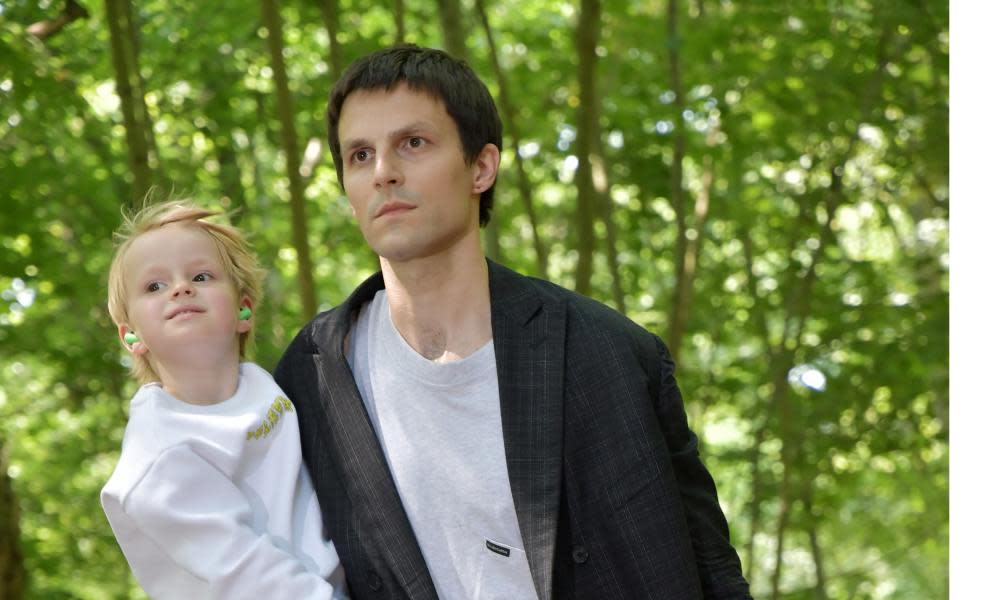I’m not going to tell you again: we’ve hit Peak Dad | Jeremy Davies

Like many fathers of 17-year-olds, I’ve become accustomed to my son nicking clothes out of my wardrobe. I’ve put this behaviour down to laziness, combined with the poverty of youth. If I’m honest, I had taken it as a backhanded compliment too – a sign that maybe I’m not so past it after all.
But now I’ve discovered that he’s just doing what teenagers do – following the latest sartorial trend – Peak Dad, as interpreted by Balenciaga at men’s fashion week.
No doubt the Peak Dad look has more than a twist of irony about it, if these highlights from the Fashion Dads Instagram account are anything to go by. But it’s definitely a thing. It must be, as it has featured in all manner of style magazines, from GQ and Esquire to Dazed & Confused.
So what’s going on? What does Peak Dad signify?
I’m not going to make any claims as a fashion expert, but as somebody who earns his living advocating involved fatherhood, and is reasonably up on how the media presents dads, I do reckon that lurking somewhere in this phenomenon is a cultural shift. I think it comes from a growing recognition, through personal lived experience, that a) dads exist, b) they might matter, and c) we might even want to celebrate them.
In 2011 I started a blog, Homer Simpson Must Die, in my spare time: an attempt to chronicle and analyse media representations of fatherhood. It felt at the time like a gap in the market. The blog didn’t last very long (did I mention I’m a dad?) But revisiting it now is quite interesting, because it shows how far we’ve come in the intervening years.

Not long after I started my blog, a dad from Pennsylvania went viral when he complained about a Huggies advert that played with the “hapless dad” stereotype. In the offending clip, nappies were given the ultimate test – being handled by cack-handed (literally, as well as metaphorically, one presumes) fathers. The joke misfired, and the outcry led the company to pull the commercial.
Later the same year, I railed against Procter & Gamble’s “proud sponsor of mums” Olympics campaign, and two Christmas ads by leading supermarkets (Asda and Morrisons) that effectively positioned mothers and fathers as two different species: one selfless and domestically downtrodden, the other lazy and incompetent. No prizes for guessing which was which.
Almost five years on, it feels like the world of “dads in ads” has shifted.
Yes, you’ll still encounter the hapless dad – or his new best mate, the fundamentally lazy but creative “dad hack” dad. There’s a touch of dad-bashing in the Peak Dad phenomenon, but it’s different, more sympathetic.
It’s worth clarifying that there is still a long way to go before dads and mums inhabit a level playing field as workers and caregivers. Men still do just 24 minutes’ childcare for every hour done by women, the gender pay gap is 18%, and we have the most gender-unequal parenting leave system in the developed world.
But it feels like brands are finally noticing that younger fathers especially are taking a fairer and more active role in parenting, or at least want to (nearly half of dads under 35 would take a pay cut to spend more time with their children). Positive, hands-on fatherhood is becoming normalised.
My theory is that this is finally happening because today’s advertising and marketing executives have “lived experience” of dads who did their best to put food on the table and be a positive presence in the home, or who did all the hands-on parenting (albeit part-time, mostly) post-divorce. Some of them are now “living the dream” of hands-on fathering themselves, and then reflecting it back at us.
Could it be that this newfound recognition of dads’ fearless, stereotype-busting “doing” of fatherhood in a world that still positions mums as the parenting experts is the inspiration behind Peak Dad? A glance at its poster-boy, Barack Obama – by anyone’s estimation, a man who seems to have achieved career success and a high level of involvement in his children’s lives – suggests to me that it might be.
Fashion is, I suppose, about finding your tribe – communicating something about your beliefs, values and background to the people around you. Sometimes we look far afield for our inspiration; sometimes we look close to home, for comfort. I asked my son what he thought of Obama’s style. A quick sweep of Google Images and the answer came: “Yeah… he’s jokes.” And then, as if by magic, he stroked my arm and gave me his best pleading look: “By the way, have you got that sweatshirt I was going to borrow?”

 Yahoo News
Yahoo News 
